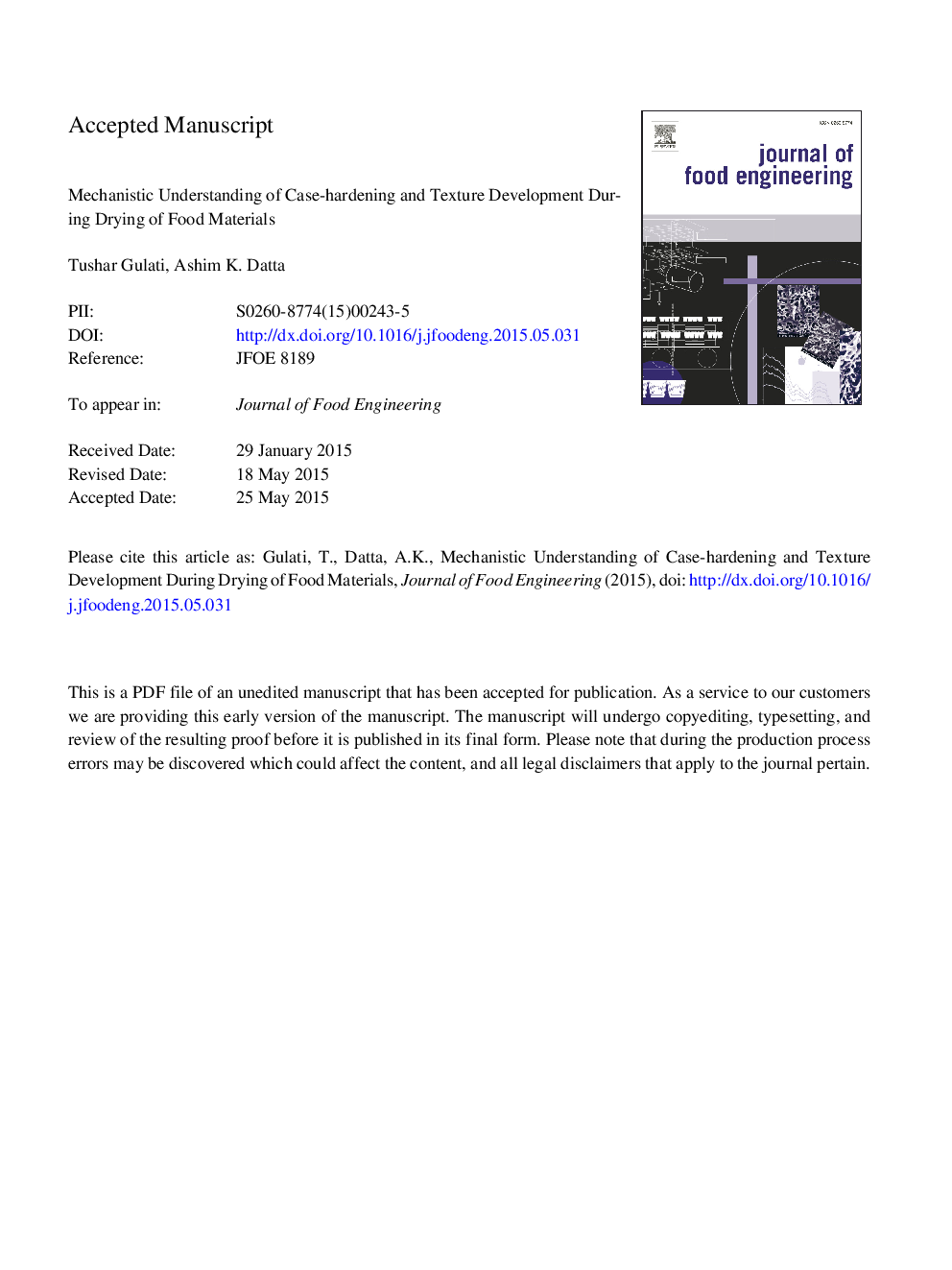| کد مقاله | کد نشریه | سال انتشار | مقاله انگلیسی | نسخه تمام متن |
|---|---|---|---|---|
| 6665157 | 464310 | 2015 | 64 صفحه PDF | دانلود رایگان |
عنوان انگلیسی مقاله ISI
Mechanistic understanding of case-hardening and texture development during drying of food materials
ترجمه فارسی عنوان
درک مکانیکی از سختی و رشد بافت در طی خشک کردن مواد غذایی
دانلود مقاله + سفارش ترجمه
دانلود مقاله ISI انگلیسی
رایگان برای ایرانیان
کلمات کلیدی
سخت شدن مورد، انتقال شیشه، بیش فعالی، حمل و نقل چند فاز، کیفیت غذا،
ترجمه چکیده
چارچوب مکانیکی برای توسعه کیفیت مانند انقباض و سخت شدن مورد در خشک کردن، امکان بینش جدیدی را فراهم می آورد که کیفیت نهایی را در فرآیند خشک کردن قابل پیش بینی تر و قابل کنترل تر می کند. یک مدل پورومکانیک که شامل چند مرحله (ماتریس جامد / آب مایع / بخار جامد) و تغییر شکل بزرگ با استفاده از رابطه ساختاری هیپرآلاستیک بین استرس و فشار است توسعه یافته است. رطوبت و حالت (لاستیک / شیشه ای) وابسته به خواص مکانیکی و حمل و نقل استفاده می شود. الگوی انباشتگی پیچیده که به سادگی با مقدار از دست رفته آب برابر با مقدار رطوبت کم به علت انتقال شیشه ای ماده مشاهده نمی شود. برای خشک شدن زیاد، سطح خشک شدن سریعتر از هسته ایجاد می کند و یک لایه سخت را ایجاد می کند که منجر به انحرافات اولیه در انقباض می شود. در مقابل، برای نرخ خشک شدن کم، انحراف در انقباض در رطوبت بسیار پایین به علت انتقال تدریجی لاستیک / شیشه رخ می دهد. ویژگی های کلیدی کیفیت، مانند درجه تشکیل پوسته، از مبانی پیش بینی شده است.
موضوعات مرتبط
مهندسی و علوم پایه
مهندسی شیمی
مهندسی شیمی (عمومی)
چکیده انگلیسی
A mechanistic framework for quality development such as shrinkage and case hardening in drying would allow new insights making the final quality in a drying process more predictable and controllable. A poromechanics model that includes multiphase (solid matrix/liquid water/vapor) transport and large deformation using hyperelastic constitutive relationship between the stress and strain is developed. Moisture and state (rubbery/glassy) dependent mechanical and transport properties are used. A complex shrinkage pattern that is not simply equal to the amount of water lost is observed at low moisture contents due to glass transition of the material. For high drying rates, the surface dries out faster than the core and forms a case-hardened layer resulting in early deviations in shrinkage. In contrast, for low drying rates, deviations in shrinkage occur at extremely low moisture contents due to a gradual rubbery/glassy transition. Key quality attributes, such as degree of crust formation, are predicted from fundamentals.
ناشر
Database: Elsevier - ScienceDirect (ساینس دایرکت)
Journal: Journal of Food Engineering - Volume 166, December 2015, Pages 119-138
Journal: Journal of Food Engineering - Volume 166, December 2015, Pages 119-138
نویسندگان
Tushar Gulati, Ashim K. Datta,
